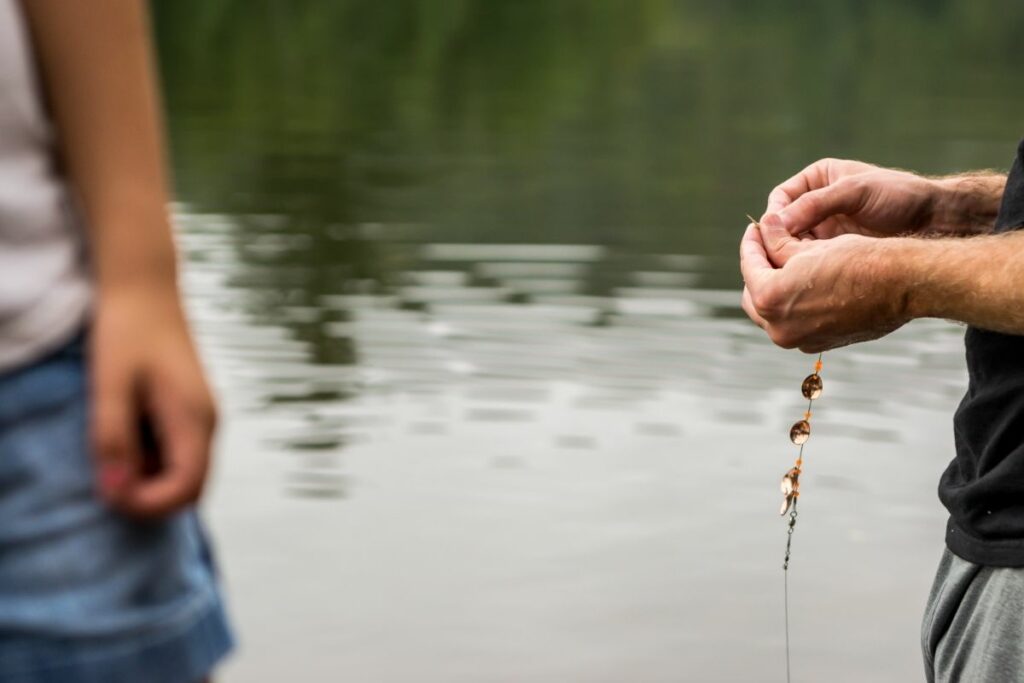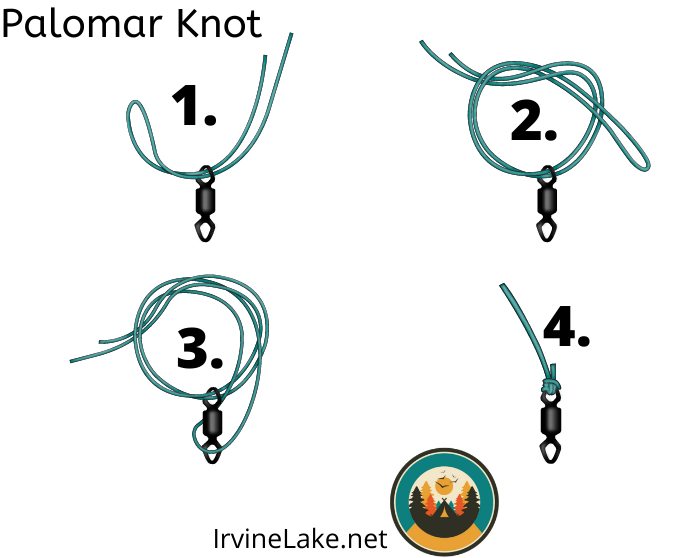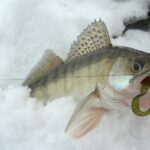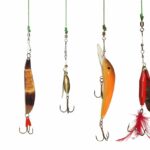The following is a guide to tying the Palomar Knot. Could it be the best fishing knot ever? Well, it has been dubbed so before. If tied correctly, the Palomar Knot comes close to being pretty dang perfect, and it will no doubt help you to improve your catch rate a great deal.

The Palomar Knot works well with a range of baits and can withstand more abuse during fish-catching than other knots. Sound good? Great! We’re going to tell you how you can get the Palomar Knot done correctly!
Steps On How To Tie The Palomar Knot Yourself
The purpose of this section is to explain how you can tie the Palomar Knot for yourself and use it for your next fishing trip. We are confident that when you use this knot for the first time, you will be amazed by the results.
Through The Hook Eye, Thread The Line
Put your thumb and pointer finger on the fishing hook and hold it vertically. Pull about 12 inches of fishing line from the head of the hook, and poke the fishing line back through the eye.
This is your starting point for the knot. You need to do this step correctly in order to proceed and successfully tie the Palomar Knot.
Reconnect The Hook Eye To The Line
Poke the fishing line back through the eye of the hook after pulling the tag line through. There should be about six inches of line attached to the hook eye, the looped end through the hook eye, and the tag end of the line.
This is so you’ll have enough line on the hook to pass completely through the loop after you make your overhand knot.
Push the line through the eye of the hook without pinching it. Pinching a very fine line will cause a kink that will end up in your line snapping in the later stages of tying the knot.
Before you tie an overhand knot, make sure that the reel line and tag line aren’t looped around one another.
Knot An Overhand Knot
With both lines on top of each other, tie a straightforward overhand knot. The coiled line should cross over the tag line, as well as the line that leads to the rod and reel.
Under the tag and reel lines, turn the looped line around and tighten it slowly. Check that the hook is tucked under the loose knot at the bottom.
Allow some room in the coiled piece of line for the hook to be inserted into the middle of the loop later.
Through The Loop, Place The Hook
Place the finishing hook through the loop at the end of the line while holding the overhand knot between your pointer and thumb.
All lines should be gently pulled back to ensure there are no tangles on the hook or within the sometimes gritty region around the eye.
You should make sure that all parts of the knot are cinched together when passing the hook or lure through the loop.
In many representations of this knot elsewhere, it appears that the loop part of the knot goes over the eye of the hook or lure. Tying this knot that way can lead to failure.
Tighten The Knot
Make sure that the knot is as tight as possible. It is a good idea to moisten your line and the knotted area near the eye on the hook with your mouth and tongue.
Grasp the hook tightly with a hand and release the line looped around your thumb. With your other hand, make sure that the main line and the tag line are parallel so that the knot ends up as secure as possible.
Whether you smooth the knot with saltwater or a solution, the friction between lines can be reduced, which lowers the likelihood of the line breaking later on.
Final knots should be tied on or near the hook eye, rather than on the hook shank or at the bottom of the hook eye.
Cut The Tagline
Finally, if you want to be sure the knot is tight, cut the tag line from the line that goes back to the reel. Pull both lines in opposing motions. Remove the leftover tag line with scissors, but for a few centimeters.

Palomar Knot Benefits
Palomar knots have a strength of 95 percent, which is excellent. Using the Palomar knot when the fishing line has a minimum tensile strength of 20 pounds is a good choice.

Knots like this one are simple to tie, so they can also be tied quickly.
Due to the fact that this fishing knot is double-run through the hook eye, knotted, then looped over the hook or lure, it may tangle more easily, but it remains a strong and effective knot.
And being that it’s such a powerful tool, you’ll want to practice tying this fishing knot as much as possible if you are learning how to fish.
Frequently Asked Questions
What Is A Palomar Knot?
A fishing line can be tied to fish hooks using the Palomar knot, a sturdy and reliable knotting technique. Additionally, they can be used on both braided fishing lines and thin, monofilament fishing lines, making them versatile.
Why Does My Palomar Knot Keep Breaking?
Attempting to tie a Palomar knot with a kinked line or crossed lines can cause the knot to fail. You will also need line lubricant if you’re using a fluorocarbon line, which can cause the knot to overheat and fail.
What Is A Palomar Knot Used For?
Palomar knots attach fishing lines to hooks, snaps, snap-clamps and swivels, and flies to leaders and tippets. Despite the fact that it performs well with monofilament, fluorocarbon and braided fishing lines, it performs best with monofilament.
What Is The Success Rate Of The Palomar Knot?
Knots like this one retain nearly 100 percent of the strength of the fishing line. According to the International Game Fish Association, the Palomar knot is the closest you can get to a lobster knot as it is tested for braided, monofilament and fluorocarbon fishing lines.
What Are The Negatives Of The Palomar Knot?
If you are using large lures, the palmer knot has its main disadvantage. The feeding of a larger lure through the loop is a bit more challenging, but it is possible if you use slightly more line to create a bigger loop.
As a result of using more line, you will have a slightly longer tag end when you’re finished tying. There’s a little more waste, but the advantage of strength to size outweighs it.
Summary
If you followed these steps correctly, you will have successfully tied the Palomar Knot — hooray! This should be ready for use immediately, so line up your bait and put it in the water to start catching fish for dinner.
Don’t worry if you haven’t quite got it down just yet. These things take practice, so don’t be discouraged, pick up some more lines and hooks and try, try, try again. You’ll have the Paloma knot mastered in no time!
I am certain that the more experienced fishermen out there will have heard about the Palomar knot prior to us explaining it to you, but now it can be added to your repertoire of knowledge regarding fishing.
If you adhere to the instructions correctly, you are going to encounter a high rate of success on your trip.
- Do You Need An Indicator For Nymph Fishing? - November 16, 2023
- Fishing Safety Tips For Families - September 25, 2023
- What Is The Best Time To Night Fish At A Lake? - September 18, 2023


![How To Tie A Fishing Hook To A Line? [Quickly And Easily] How To Tie A Fishing Hook To A Line? [Quickly And Easily]](https://irvinelake.net/wp-content/uploads/2022/04/How-To-Tie-A-Fishing-Hook-To-A-Line-Quickly-And-Easily-150x150.jpg)






